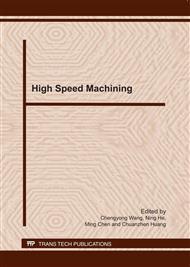p.199
p.203
p.208
p.212
p.216
p.220
p.224
p.230
p.236
Study on Residual Stress for High-Speed Cutting Titanium Alloy Based on Finite Element Method
Abstract:
In order to improve machined surface quality and reduce the deformation, the residual stress involved in cutting titanium alloy was studied under different cutting speed and cutting depth by finite element simulation method. The results indicate that the increase of cutting speed and cutting depth are helpful to the surface residual compressive stress generating. However the increase of cutting speed also leads to the increase of surface residual tensile stress, the effect degree is relatively small. It is required to select higher cutting speed and smaller cutting depth to improve the surface stress state and reduce the unexpected distortion.
Info:
Periodical:
Pages:
216-219
Citation:
Online since:
March 2011
Authors:
Price:
Сopyright:
© 2011 Trans Tech Publications Ltd. All Rights Reserved
Share:
Citation:


